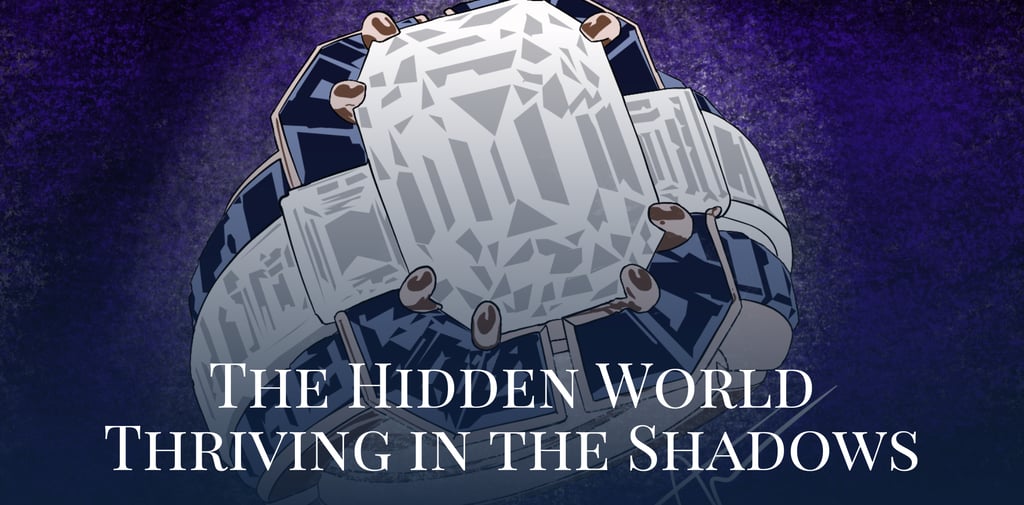The Hidden World Thriving in the Shadows
11/1/20254 min read


I used to watch the spotlight. It shone brightly on the Alphas and Betas, demanding constant validation, daily activity, and noisy visibility. They believed success was measured in volume. They posted daily, attended everything, and treated their lives like an open-source project. And for a long time, I bought into the pressure that I, too, had to be available, accessible, and constantly on.
But the spotlight is a demanding mistress. It drains energy, invites cheap criticism, and most importantly, it exposes all your work before it's truly finished. I realized the people who were loudest were often the ones achieving the least meaningful progress. They were spending all their capital on marketing their potential instead of mastering their craft.
The Discovery: The High Leverage Shadow
My shift began when I recognized that noise is cheap, but deep work is priceless. I was tired of giving my most potent commodity, my focused attention, away for free.
I decided to retreat. I didn't quit; I simply became strategically unavailable. I went dark on the low leverage activities that consume 90% of most people's time: the casual scroll, the obligatory meeting, the response to the low intent email.
This is the hidden world thriving in the shadows. It's a place where:
You work on the thing that moves the needle 10x, not 10%.
Your ideas get the uninterrupted silence required to reach full refinement.
Your scarcity becomes your quality control mechanism.
I wasn't hiding; I was cultivating rarity. Every day I spent in the shadow was an investment that compounded the value of the day I would eventually step back into the light.
Scarcity Dictates the Price
True power isn't in constant visibility; it's in the shockwave created by a rare, perfectly timed appearance. If you only speak when you have something exceptional to say, the market will listen with exceptional attention. You no longer have to fight for attention; your silence has earned you the right to command it.
The luxury mindset isn't about being seen in the right places; it's about making sure that when you are seen, the quality of your presence is undeniable.
Three Luxury Filters for the Sigma Mind
These models help filter out the noise, reserving your energy for opportunities that offer the highest return on your scarcity.
1. The Scarcity/Impact Matrix
This filter helps you instantly categorize and eliminate low value opportunities by assessing two criteria: how scarce the opportunity is (how many people can do it) and what its actual impact will be.
I. High Scarcity / High Impact
You are uniquely qualified; the outcome is transformative.
Sigma Strategy (The Luxury Choice): Invest Everything: This is your core work. Charge a premium for the singularity of your skill.
II. Low Scarcity / High Impact
Important work, but many people can do it (e.g., standard administrative tasks).
Sigma Strategy (The Luxury Choice): Delegate or Systemize: Use your financial capital to buy back your time. Your skill is too expensive for this work.
III. High Scarcity / Low Impact
Niche, but irrelevant. Tasks only you can do, but they lead nowhere (e.g., hyper-specific, unnecessary research).
Sigma Strategy (The Luxury Choice): Immediately Eliminate: This is the niche trap. It feels busy, but it’s a distraction masquerading as deep work.
IV. Low Scarcity / Low Impact
Common, irrelevant, and time consuming (e.g., most social media commentary, generalized meetings).
Sigma Strategy (The Luxury Choice): Ignore: Absolute waste of time and attention. Your energy is too valuable for this quadrant.
Use this to visually triage your to do list. The goal is to spend 90% of your time in Quadrant I, treating your unique ability as your ultimate luxury product.
2. The Friction Test (The Elegance of Flow)
A luxury experience is seamless, effortless, and high quality. If a decision or opportunity introduces unnecessary friction, it automatically degrades your life's quality, making it less "luxurious."
The Rule: If a project or person costs you disproportionate mental energy, time, or emotional stability relative to the tangible outcome, the true cost is too high.
Ask Yourself: "Is this opportunity adding friction to my daily system, or eliminating friction for others? Am I absorbing chaos, or creating flow?"
Filter Example (Project): A high paying client project that requires constant, unscheduled communication, forcing you to break your deep work blocks. Result: Reject. The hidden cost of the destroyed focus outweighs the fee.
Filter Example (Habit): Organizing your workspace for 10 minutes every day to ensure every tool is exactly where it needs to be before a 4 hour deep work session. Result: Accept. The investment of low friction time buys back high friction time.
3. The "Would I Pay for This?" Principle
This principle is about eliminating opportunities you take simply because they are offered or free. You must put a financial price on your time and then ask if the opportunity meets that price, even if no money is exchanged.
Determine Your Focus Rate: Calculate the hourly value of your most impactful, unique work (e.g., $500/hour).
Evaluate the Ask: When someone asks you to "pick their brain," attend a mandatory meeting, or volunteer for a generalized task, calculate the time it will take. (e.g., 1 hour meeting = $500).
The Luxury Swap: Ask: "If this person or opportunity had to pay me $500 cash for this hour, would the outcome justify the spend?"
If the answer is no, you decline, not because you're greedy, but because you are respecting the actual, non-negotiable value of your scarce time. This is the ultimate expression of the luxury mindset: valuing your time so highly that you treat it with the respect of a premium currency.
